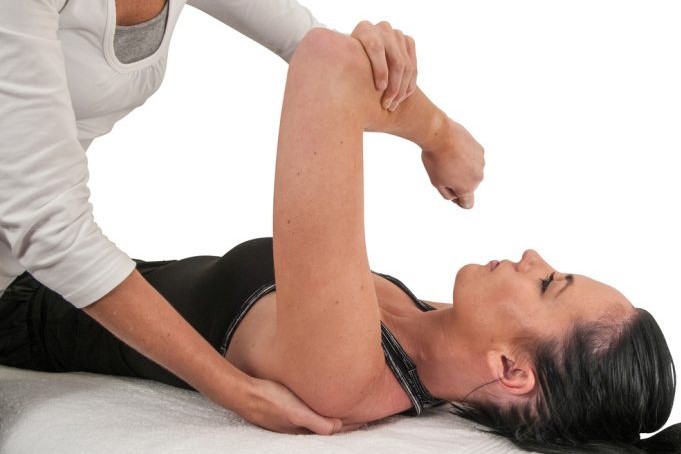
The 10 most frequent causes of shoulder pain
Most common causes of shoulder pain: shoulder movements are among the most frequent in a person’s life and, therefore, it is much easier than for other joints for a series of events to occur that lead to shoulder pain
Let us therefore see why shoulder pain can occur
Tendonitis of the CLB (long head biceps)
This is an inflammation of the tendon of the long head of the biceps brachii.
This tendon is more likely to become inflamed than its competitor Capo Breve Bicipite (CBB).
The pain is mainly present in a limited area in the front of the shoulder.
Rupture of the CLB tendon
This is a serious event that affects people of all ages.
It is more likely to be traumatic in young people and degenerative in older people.
The rupture of the tendon causes pain in the young person, but in the elderly person it can even be the spontaneous solution to a painful anterior shoulder symptom.
Cuff tendonitis
This is an inflammation of the tendons of the ‘shoulder rotator cuff’ (supraspinatus, subspinatus, subscapularis, small round).
Not always all the tendons of the cuff are involved, but sometimes one or two.
It causes pain in the shoulder that is located differently depending on the inflamed tendon.
Symptoms may be redness, joint stiffness, loss of joint function.
Rotator cuff
Consists of four muscles (supraspinatus, subspinatus, subscapularis, small round), which help to move and stabilise the shoulder joint.
Impairments to one of these four muscles or their tendons can occur due to acute post-traumatic injuries, continuous and excessive overuse or progressive ageing.
Again, the pain depends on the muscle involved.
Frozen shoulder
This is a pathological condition that causes severe limitation of shoulder movement.
The aetiology of frozen shoulder is not well known.
It often occurs without any apparent cause.
The pain experienced is spread over the entire shoulder, but particularly as soon as slight movement is hinted at.
Calcific tendonitis
This is a pathological condition that causes the formation of small calcium deposits, usually around 1-2 centimetres in size, within the tendons of the rotator cuff.
The pain varies depending on the tendon affected.
Shoulder instability/luxation
Occurs when the structures surrounding the scapular/humeral joint, responsible for stabilising it, no longer act to keep the shoulder in its normal position.
Causes may be
- traumatic
- atraumatic
- acquired.
In acute cases, it is a very dramatic event that requires immediate hospital care.
In subluxation cases, on the other hand, the shoulder pain varies depending on the type of subluxation.
Laceration of the glenoid labrum
The shoulder joint is like a spinning ball in a cup.
However, the tightness of the shoulder joint is extremely shallow, and therefore inherently unstable.
To compensate for this low tightness, the shoulder joint has a kind of seal called a ‘labrum’ that increases stability.
This ‘seal’, allows a wide range of movement to the shoulder (in reality, the range of movement the shoulder can make far exceeds any other joint in the body).
This type of pain is very variable.
SLAP lesion
This is a lesion of the upper edge of the glenoid ‘labrum’ with disconnection of the CLB tendon.
This is a subtle pathology since, in the initial stages, it may not even cause pain, but over time it manifests itself not only with pain but also with a limitation of articulation and a certain degree of instability.
Shoulder pain: arthrosis
This is the most common type of shoulder pain in people over 50.
It is also called degenerative joint disease.
Arthrosis is characterised by a progressive erosion of the cartilage of the shoulder joint.
It contributes to or may be the only cause in what is called Senile Shoulder Pain.
Should you have any further questions to ask, you can do so by requesting a consultation in the orthopaedics area.
Read Also
Emergency Live Even More…Live: Download The New Free App Of Your Newspaper For IOS And Android
Symptoms, Diagnosis And Treatment Of Shoulder Arthrosis
Frozen Shoulder Syndrome: What It Is And How To Treat It
Shoulder Instability And Dislocation: Symptoms And Treatment
Shoulder Tendonitis: Symptoms And Diagnosis
Dislocation Of The Shoulder: How To Reduce It? An Overview Of The Main Techniques
Frozen Shoulder Syndrome: What It Is And How To Treat It
Arthrosis: What It Is And How To Treat It
Arthrosis: What It Is And How To Treat It
Juvenile Idiopathic Arthritis: Study Of Oral Therapy With Tofacitinib By Gaslini Of Genoa
Rheumatic Diseases: Arthritis And Arthrosis, What Are The Differences?
Rheumatoid Arthritis: Symptoms, Diagnosis And Treatment
Joint Pain: Rheumatoid Arthritis Or Arthrosis?
The Barthel Index, An Indicator Of Autonomy
What Is Ankle Arthrosis? Causes, Risk Factors, Diagnosis And Treatment
Unicompartmental Prosthesis: The Answer To Gonarthrosis
Knee Arthrosis (Gonarthrosis): The Various Types Of ‘Customised’ Prosthesis
The Most Frequently Asked Questions In A First Aid Class
First Aid And Epilepsy: How To Recognise A Seizure And Help A Patient
F. Aid In Case Of Food Poisoning
F. Aid, Fractures (Broken Bones): Find Out What To Look For And What To Do
Cardiac Syncope: What It Is, How It Is Diagnosed And Who It Affects
First Aid And Emergency Interventions: Syncope
First Aid: Common Causes Of Shoulder Pain And How To Prevent It


